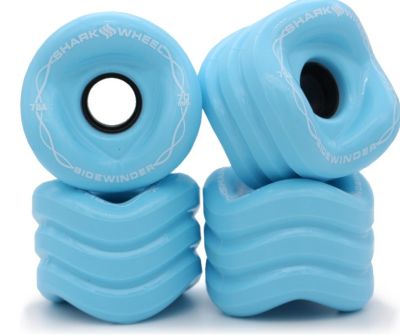Square wheels–or more precisely, those with a sinusoidal circumference–have several advantages over conventional round wheels. So say the inventors of what is probably the world’s only square-shaped commercial wheels.

Shark Wheels for skateboards.
Devised by the start-up firm called Shark Wheel in Orange County, Calif., the wheels already are used on skateboards. Shark Wheel just released its second square-wheel-equipped device, a ride-on electric car for kids up to eight years old. Shark Wheel company officers say they also have several other products in development that include wheels for luggage, agricultural equipment, wheel chairs, ambulance beds, other similar applications.
The square wheel concept is patented and has been checked out by academic researchers at the San Diego State University mechanical engineering department. “One of the goals was to have the stress be pushed away from the center hub to minimize drivetrain issue/gearbox-like failures,” explains Shark Wheel CEO and co-founder Zack Fleishman. As described in the patent, ordinary wheels typically have tire surfaces that are fully in and aligned with their plane of rotation. That’s not the case for the Shark Wheel. The center line of the Shark Wheel tire surface varies from the plane of rotation as a sinusoid. The tire surface circumscribes the

Some of the concept drawings from the Shark Wheel patent.
Shark Wheel creators say one advantage of the wheel shape is that it provides the stability of a wider tire footprint but with the lower surface friction drag of a narrow tire. The 30° approach angle of the Shark Wheel used on skateboards strikes obstacles at an angle and tends to push them left and right out of the way. In contrast, a traditional wheel acts like a steamroller and tries to go over objects. The angle also reduces shock significantly. In pallet jack/forklift wheels, Shark Wheels are said to last 50% longer because they dissipate heat in a sine wave footprint. In casters, Shark Wheels are said to have 57% less friction when in motion making so things are easier to push. In farming, the oscillatory pattern of Shark Wheels significantly minimizes trench digging, a nuisance in cultivated fields. Shark Wheel creators say a recent government test showed Shark Wheels dug a 1-in trench while the industry leading wheel dug a 14-in trench.
The Shark Wheel website mentions pneumatic tires would work on square wheels, but the wheels using the concept so far all are solid wheels. Shark Wheel creators think pneumatic wheels are a possibility, but also say each industry they’ve designed for to date prefers solid wheels. For example, they say 85% of irrigation wheels in agriculture are pneumatic, but that industry craves a solution that works just as well or better that can never go flat. Shark Wheel principals also admit at this point they have only brainstormed a fully pneumatic design, though they think it can absolutely be done. “Most everything we R&D is a challenge,” Shark Wheel CEO Fleishman says. “There is no blueprint to making a sinusoidal wheel.”

The Shark SUV for kids.
You may also like:
Filed Under: NEWS • PROFILES • EDITORIALS, MOTION CONTROL








